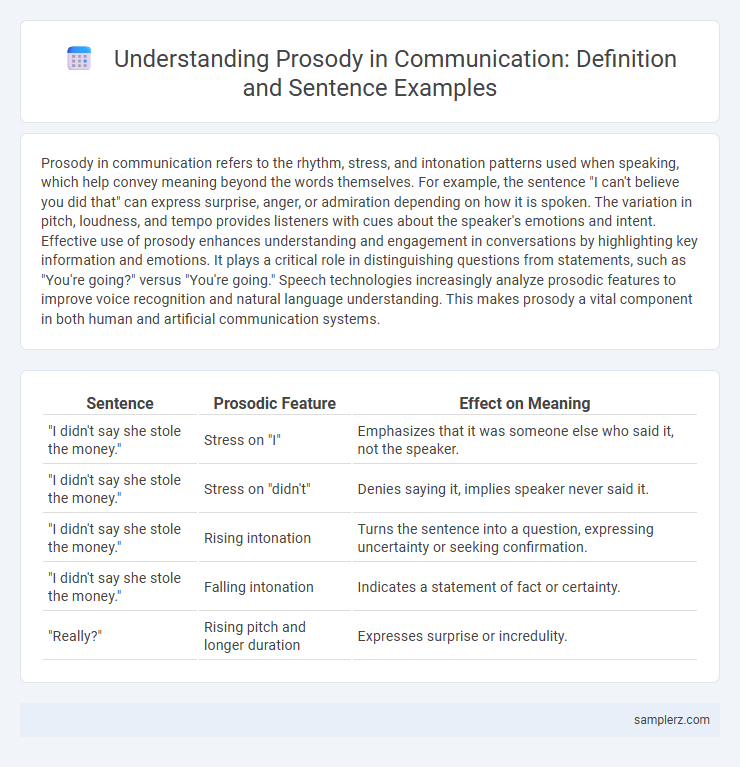Prosody in communication refers to the rhythm, stress, and intonation patterns used when speaking, which help convey meaning beyond the words themselves. For example, the sentence "I can't believe you did that" can express surprise, anger, or admiration depending on how it is spoken. The variation in pitch, loudness, and tempo provides listeners with cues about the speaker's emotions and intent. Effective use of prosody enhances understanding and engagement in conversations by highlighting key information and emotions. It plays a critical role in distinguishing questions from statements, such as "You're going?" versus "You're going." Speech technologies increasingly analyze prosodic features to improve voice recognition and natural language understanding. This makes prosody a vital component in both human and artificial communication systems.
Table of Comparison
| Sentence | Prosodic Feature | Effect on Meaning |
|---|---|---|
| "I didn't say she stole the money." | Stress on "I" | Emphasizes that it was someone else who said it, not the speaker. |
| "I didn't say she stole the money." | Stress on "didn't" | Denies saying it, implies speaker never said it. |
| "I didn't say she stole the money." | Rising intonation | Turns the sentence into a question, expressing uncertainty or seeking confirmation. |
| "I didn't say she stole the money." | Falling intonation | Indicates a statement of fact or certainty. |
| "Really?" | Rising pitch and longer duration | Expresses surprise or incredulity. |
Understanding Prosody: Key Elements in Sentences
Prosody in communication involves variations in pitch, rhythm, and stress that shape the meaning and emotional tone of sentences. For example, the sentence "You're going?" can indicate curiosity, surprise, or doubt depending on intonation patterns. Understanding prosody enhances comprehension by revealing speaker intent beyond literal words, improving both verbal interaction and effective messaging.
The Role of Intonation in Conveying Meaning
Intonation significantly influences the meaning of a sentence by varying pitch contours to signal questions, statements, or emotions, such as rising intonation indicating a question or uncertainty. For example, the sentence "You're coming" can convey a confirmation, a question, or surprise depending on the intonation pattern used. This prosodic element helps listeners interpret speaker intent beyond the literal words, enhancing effective communication.
Examples of Stress Patterns in Everyday Speech
Stress patterns in everyday speech significantly influence meaning and clarity, as demonstrated in sentences like "I didn't say she stole the money," where shifting stress changes the focus and implication. Emphasizing different words within the sentence alters interpretation, such as stressing "didn't" to deny the action or "she" to suggest someone else. These variations highlight the importance of prosody in effective communication and understanding.
How Rhythm Shapes Sentence Interpretation
Rhythm in prosody influences sentence interpretation by emphasizing specific words, altering meaning and emotional tone. For example, varying the stress pattern in the sentence "I never said she stole my money" highlights different implications, affecting listener perception. This rhythmic modulation guides listeners in understanding intent and nuance beyond the words themselves.
Pitch Variations: Enhancing Communication Effectiveness
Pitch variations in prosody significantly influence sentence meaning by signaling emotions and intentions, such as rising pitch indicating a question or uncertainty and falling pitch conveying certainty or finality. Effective use of pitch modulation enhances listener engagement, aids in disambiguating statements, and fosters clearer interpersonal communication. Studies in communication reveal that speakers who employ varied pitch patterns are perceived as more expressive and persuasive, improving overall message effectiveness.
Emotional Tone: Prosody’s Impact on Sentiment
Prosody shapes emotional tone by modulating pitch, rhythm, and stress patterns in speech, directly influencing how sentiment is perceived. For example, a rising intonation can convey excitement or uncertainty, while a falling tone may express finality or sadness. These vocal variations enhance communication by providing nuanced emotional context beyond the literal meaning of words.
Pausing and Pacing: Influencing Listener Perception
Pausing strategically within a sentence like "I never said she stole the money" can alter its meaning significantly, emphasizing different words to impact listener interpretation. Controlled pacing, such as slowing down before key points, enhances comprehension and conveys importance, shaping the listener's engagement. These prosodic features play a crucial role in effective communication by guiding emotional response and clarity.
Prosody Differences Across Questions and Statements
Prosody variations significantly influence the interpretation of questions and statements, with rising intonation typically signaling a question, while falling intonation indicates a statement. For example, the sentence "You're coming" rises at the end when asked as a question, but falls when used as a statement to confirm information. These prosodic differences help listeners discern intent and clarify meaning in spoken communication.
Illustrating Sarcasm and Irony Through Prosody
Sarcasm and irony are often conveyed through prosody by altering pitch, tone, and rhythm to contrast the literal meaning of words. For example, the sentence "Oh, great job!" can indicate sincere praise with a flat, neutral tone or sarcastic criticism when spoken with exaggerated pitch and slow tempo. These vocal cues help listeners detect the speaker's true intent beyond the surface semantics.
Practical Examples: Prosody in Real-life Conversations
Prosody in real-life conversations is evident through variations in pitch, stress, and rhythm that convey emotions and clarify meaning, such as raising the pitch at the end of a question to signal inquiry. Stressing specific words, like emphasizing "really" in "I really enjoyed the movie," intensifies the speaker's sentiment and guides listener interpretation. These prosodic features enhance communication by providing contextual cues that enrich spoken interactions beyond the literal words used.

example of prosody in sentence Infographic
 samplerz.com
samplerz.com